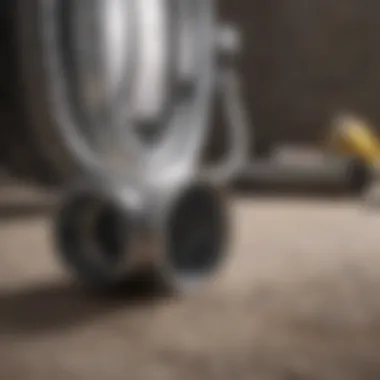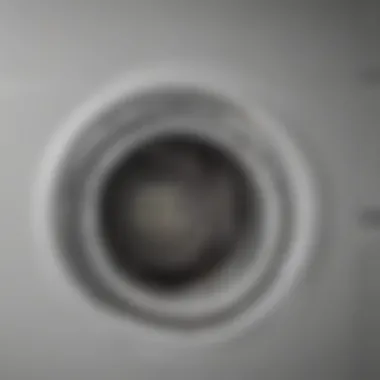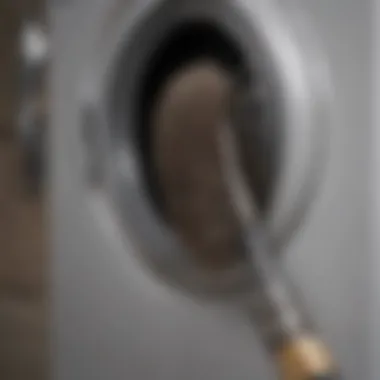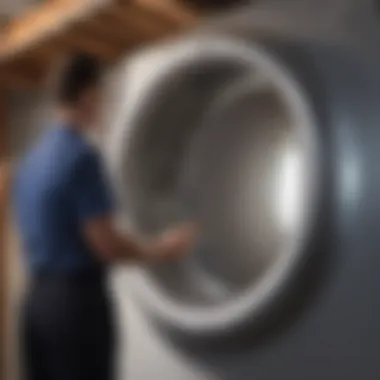Expert Guide to Cleaning a Flexible Dryer Duct for Optimal Performance


As a diligent homeowner, ensuring the cleanliness and functionality of your flexible dryer duct is crucial for both efficiency and safety reasons. By following a meticulous cleaning process, you can optimize the performance of your dryer while minimizing the potential risks associated with a clogged or dirty duct.
To commence the cleaning process, gather all the necessary tools and equipment, including a vacuum cleaner with a long hose attachment, a vent brush, a screwdriver, and protective gear such as gloves and a mask to shield yourself from debris. It is imperative to prioritize safety throughout the cleaning procedure to avoid any mishaps.
The first step involves unplugging the dryer from the power source to eliminate the risk of any electrical hazards. Proceed by moving the dryer away from the wall to access the duct easily. Carefully disconnect the duct from the dryer and the wall vent, ensuring not to damage the connections in the process.
Inspect the removed duct for any visible accumulation of lint, dust, or debris. Utilize the vacuum cleaner with a long hose attachment to thoroughly vacuum the interior of the duct, removing any obstructions that could impede airflow. Next, employ the vent brush to scrub the inner walls of the duct, dislodging stubborn buildup and ensuring a clean and unobstructed passage.
After cleaning the duct's interior, focus on the dryer vent located on the exterior of your home. Use the vent brush to remove any lint or debris trapped in the vent openings, promoting proper ventilation and preventing potential fire hazards. Additionally, check the vent cover for any blockages or damage that may obstruct airflow.
Once the cleaning process is complete, reattach the flexible duct to both the dryer and the wall vent, securing the connections tightly to prevent air leaks. Take this opportunity to plug the dryer back into the power source and conduct a test run to ensure that everything is functioning correctly.
Introduction
In the realm of household maintenance, few tasks are as crucial yet often overlooked as cleaning the flexible dryer duct. A flexible dryer duct plays a vital role in a dryer's operation, assisting in venting hot, moist air outside during the drying process. However, over time, these ducts can accumulate lint, dust, and debris, posing a significant fire hazard. This article delves into the essential aspects of cleaning a flexible dryer duct, shedding light on the importance of regular maintenance to ensure optimal performance and safety.
When the dryer duct is clogged, it restricts the airflow, causing the dryer to work inefficiently and consuming more energy. Moreover, the trapped lint can ignite under high temperatures, leading to a potentially devastating house fire. Understanding the significance of keeping the dryer duct clean is vital for every homeowner to safeguard their property and loved ones.
Furthermore, neglected dryer ducts can also affect the lifespan of the dryer itself. A blocked duct forces the appliance to work harder, resulting in unnecessary wear and tear on its components. By addressing this maintenance task proactively, homeowners can extend the longevity of their dryer and prevent costly repairs down the road. Recognizing these implications emphasizes the necessity of including dryer duct cleaning as a routine part of home maintenance and safety practices.
Importance of Cleaning Dryer Ducts
Cleaning dryer ducts is a crucial maintenance task that often gets overlooked but plays a vital role in the efficiency and safety of your dryer. Over time, lint, debris, and dust can accumulate in the ducts, leading to reduced airflow and increased risk of fires. By ensuring regular cleaning of your dryer ducts, you not only improve the performance of your dryer but also mitigate the potential hazards associated with clogged ducts.


One of the key benefits of cleaning dryer ducts is energy efficiency. When lint and debris obstruct the flow of air in the ducts, the dryer has to work harder to dry clothes, consuming more energy in the process. By keeping the ducts clear, you can optimize the airflow, reduce energy consumption, and lower your utility bills. Additionally, clean ducts help extend the lifespan of your dryer by reducing strain on the machine.
Moreover, maintaining clean dryer ducts is essential for fire prevention. Lint is highly flammable, and if it accumulates in the ducts and comes into contact with heat from the dryer, it can ignite easily, leading to a hazardous situation. Regular cleaning minimizes the risk of lint fires, providing peace of mind to homeowners and ensuring the safety of the property.
In addition to energy efficiency and fire safety, cleaning dryer ducts also contributes to better indoor air quality. When ducts are clogged, the accumulated debris can harbor allergens, dust mites, and other contaminants that can circulate in the air when the dryer is in use. By keeping the ducts clean, you reduce the risk of allergens being dispersed in your home, creating a healthier living environment for you and your family.
Overall, the importance of cleaning dryer ducts cannot be understated. It not only enhances the performance and longevity of your dryer but also protects your home from potential fire hazards and promotes better indoor air quality. By incorporating regular duct cleaning into your household maintenance routine, you can enjoy a more efficient, safer, and healthier living space.
Signs Your Dryer Duct Needs Cleaning
When it comes to maintaining household appliances, the dryer duct is often overlooked but plays a crucial role in ensuring safety and efficiency. Recognizing the signs indicating that your dryer duct needs cleaning is essential to prevent potential hazards and to keep your dryer functioning optimally.
One of the most telltale signs that your dryer duct requires cleaning is when your clothes take longer to dry than usual. This happens because a clogged duct restricts the airflow, making it harder for the moisture in the clothes to evaporate efficiently. As a result, you might find yourself running multiple cycles to dry a single load of laundry, leading to increased energy consumption and utility costs.
Moreover, if you notice a burning smell coming from the dryer or the laundry room, it could be a clear indication of a blockage in the duct. Lint build-up within the dryer duct is highly flammable and poses a serious fire risk. Neglecting to clean the duct regularly can escalate this danger, putting your home and loved ones at risk of a devastating fire incident.
Another sign that often goes unnoticed is excessive heat in the laundry area. A dryer duct that is packed with lint and debris prevents proper ventilation, causing the appliance to overheat. This not only reduces the dryer's efficiency but also poses a fire hazard. Monitoring the temperature in the laundry room and around the dryer can give you valuable insights into the condition of your duct system.
In addition to these warning signs, paying attention to the amount of lint accumulating around the dryer vent is crucial. If you consistently find lint particles scattered around the vent opening, it indicates that the duct is not effectively capturing and expelling lint as it should. This build-up can result in poor air circulation, higher energy consumption, and increased wear and tear on the dryer components.
Ignoring these signs and neglecting to clean your dryer duct can lead to severe consequences, from decreased appliance lifespan to potential fire hazards. By recognizing these indicators and taking proactive measures to clean your dryer duct regularly, you can ensure the safety, efficiency, and longevity of your dryer, providing peace of mind for you and your family.
When it comes to cleaning a flexible dryer duct efficiently, having the right tools and materials is crucial to ensure the task is completed effectively. In this section, we will delve into the essential items you will need to have on hand.


- Lint Brush: A lint brush is a fundamental tool for removing built-up lint and debris from the dryer duct. It is usually flexible, allowing you to navigate through the duct's curves and angles to clean thoroughly.
- Vacuum Cleaner: A high-powered vacuum cleaner with a hose attachment is indispensable for sucking up loosened lint and dirt while cleaning the duct. Make sure the vacuum has strong suction power to eliminate as much debris as possible.
- Screwdriver and Wrench: These tools are necessary for disconnecting and reattaching the dryer from the duct. Ensure you have the right sizes to fit the screws and bolts securely.
- Duct Cleaning Kit: Investing in a duct cleaning kit can simplify the cleaning process. These kits often include flexible rods and brushes designed to reach deep into the duct, ensuring a thorough cleaning.
- Gloves and Safety Goggles: Safety should always be a priority when working with dryers. Wear gloves to protect your hands from sharp edges and debris, and safety goggles to shield your eyes from dust and particles.
Before starting the cleaning process, ensure all these tools and materials are readily available. Having the proper equipment not only makes the job more manageable but also ensures a thorough and effective cleaning. Attention to detail and using the right tools will help maintain your flexible dryer duct in optimal condition, promoting efficiency and safety in your laundry routine.
Step-by-Step Guide to Cleaning a Flexible Dryer Duct
Cleaning a flexible dryer duct is a crucial maintenance task to uphold the efficiency and safety of your dryer. By following these detailed steps meticulously, you can ensure optimal performance and prevent potential hazards that may arise from clogged ducts. Proper cleaning also extends the lifespan of your dryer and reduces energy consumption, making it a cost-effective choice in the long run.
Preparation
Before embarking on cleaning your flexible dryer duct, gather all necessary tools and materials. You will need a vacuum cleaner with a narrow attachment, a screwdriver, duct cleaning brushes, mild detergent, and safety gloves. It is also recommended to wear a face mask to protect yourself from inhaling dust and debris. Ensure the dryer is unplugged to avoid any accidents during the cleaning process.
Disconnecting the Dryer
To begin the cleaning process, gently pull the dryer away from the wall to access the rear panel. Use caution while moving the dryer to prevent any damage to the flooring. Next, unplug the power cord from the electrical outlet to ensure safety. If the dryer is a gas model, turn off the gas supply before proceeding with disconnecting the dryer. Use a screwdriver to loosen the clamp that secures the duct connected to the dryer's rear.
Accessing the Duct
Once the dryer is disconnected, carefully move it to provide better access to the duct. Remove the flexible duct from the dryer exhaust and the wall vent. Inspect the duct for any signs of damage or excessive lint buildup, which may require professional intervention. Ensure there are no sharp bends or kinks in the duct that could impede proper airflow.
Cleaning the Duct
Using the duct cleaning brushes and vacuum cleaner with a narrow attachment, meticulously clean the interior of the flexible duct. Start by inserting the brush into one end of the duct and gently push it through to dislodge lint and debris. Follow this by vacuuming the loosened particles to ensure a thorough cleaning. Repeat this process until the entire length of the duct is clear of any obstructions.


Reconnecting the Dryer
After cleaning the duct, securely reattach it to both the dryer exhaust and the wall vent. Ensure the connections are tight to prevent any air leaks. Once the duct is in place, carefully push the dryer back against the wall, taking care not to crush or kink the duct. Plug the power cord back into the outlet and, for gas dryers, turn the gas supply back on. Test the dryer to verify proper airflow and functionality before resuming normal use.
Tips for Effective Dryer Duct Cleaning
In the realm of maintaining your flexible dryer duct, the significance of effective cleaning practices cannot be overstated. Ensuring that your dryer duct is clean plays a pivotal role in not just the efficiency of your dryer but also in safeguarding your home from potential fire hazards. By focusing on the tips for effective dryer duct cleaning outlined in this article, you are taking a proactive measure towards maintaining optimal performance and safety within your living space.
When delving into the realm of regular maintenance for your dryer duct, consistency is key. Regularly inspecting and cleaning your dryer duct helps in preventing the accumulation of lint and other debris that can obstruct airflow and potentially lead to overheating. This simple yet crucial routine maintenance task helps in prolonging the lifespan of your dryer, improving its efficiency, and reducing the risks of fire hazards.
Utilizing the right tools for cleaning your flexible dryer duct is a fundamental aspect of ensuring thorough and efficient maintenance. Equipping yourself with tools such as a high-quality vacuum, flexible dryer vent brush, microfiber cloth, and perhaps even a dryer vent cleaning kit facilitates a more effective cleaning process. These tools enable you to reach deep into the duct, dislodging and removing built-up debris with precision.
Checking for blockages within your dryer duct is a critical step in maintaining optimal functionality. Blockages can manifest in various forms, including lint buildup, debris accumulation, or even small animal intrusions. Regularly inspecting your dryer duct for such blockages allows you to address them promptly, preventing airflow restrictions that could lead to dryer inefficiency and safety hazards.
A professional inspection of your flexible dryer duct provides an additional layer of assurance regarding its condition. Hiring a qualified technician to conduct a thorough inspection allows for a comprehensive assessment of the duct's cleanliness and structural integrity. Professional inspections help in identifying any potential issues early on, ensuring that your dryer duct operates efficiently and poses minimal risks to your home.
Safety Precautions
When it comes to cleaning your flexible dryer duct, adhering to safety precautions is paramount. Safety measures are not just recommendations but essential practices to prevent potential hazards and ensure a secure cleaning process. One of the critical safety precautions is to disconnect the dryer from the power source before initiating any cleaning procedures. This step eliminates the risk of electrical shocks and accidents while handling the duct.
Additionally, wearing protective gear such as gloves and goggles is another crucial safety measure. These items shield you from sharp edges, debris, and dust particles that may emit from the duct during cleaning. Maintaining proper ventilation in the area where you are working is also vital to prevent inhalation of harmful substances or fumes that may be present in the duct.
Furthermore, inspecting the duct for any signs of damage or wear before starting the cleaning process is highly recommended. Any compromised areas on the duct could potentially lead to leakage or blockages, posing a risk to the dryer's efficiency and safety. By being vigilant about the condition of the duct, you can proactively address any issues that may compromise its performance.
Lastly, following the manufacturer's guidelines and recommendations for maintenance and cleaning procedures is a safety precaution that should not be overlooked. These instructions are designed to ensure optimal functioning of the dryer and prevent any mishaps that may occur due to improper maintenance practices. By meticulously adhering to safety precautions throughout the cleaning process, you can safeguard yourself and your appliance from potential risks, guaranteeing a safe and effective cleaning experience.
Conclusion
Dealing with the aftermath of cleaning your flexible dryer duct is not just about maintenance; it's a crucial aspect of ensuring your home's safety and efficiency. The significance of this process cannot be overstated, as a neglected dryer duct can lead to hazardous situations like lint buildup igniting a fire. By investing the time and effort to clean your duct regularly, you're actively mitigating such risks and safeguarding your property and loved ones.
Furthermore, a clean dryer duct directly impacts your appliance's performance. A clogged or dirty duct can hamper air circulation, leading to longer drying times and decreased energy efficiency. By maintaining a clear duct system, you're optimizing your dryer's functionality and potentially extending its lifespan, saving you from costly repairs or replacements.



